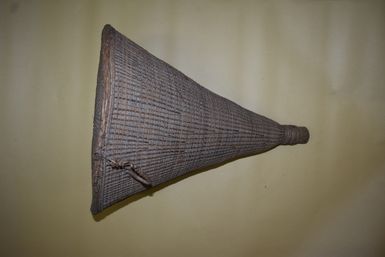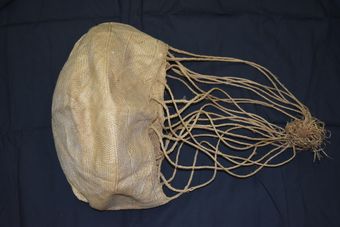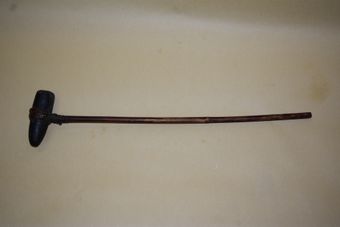Solomon Islands National Museum Objects & ArtifactsFish Trap.- Vubu (wubu)
- Description:
- This collection shows the physical objects, artifacts, and items that are held at the Museum in Honiara.For small mamamu river-put at side of river time fish are running up the river from sea. Put trap facing sea-water runs this trap and out through holes. Mamamu-mada- also caught in net but also catches dirt. Made with asa- bush fibre- This is the real size. Handle-Valingena. Stopper can use (any wood)- ghai (rai/rhai) Matana- eye- holes can be ¾ holes. Start weaving at narrow end- finish rim. Flat piece and eyes made separately can last 15 years, if kept well, hung from roof. Took 2 ½ Months to make it (hard to find asa) Women can also make them though it is men’s work.
- Display date:
- 11th July 1978
- Location:
- Solomon Islands
- Collections:
- Solomon Islands National Museum
- Content partner:
- Solomon Islands National Museum
- Availability:
- Online
-
Copyright status: All rights reservedFind out more about what you are able to do with this itemThis item is all rights reserved, with means you'll have to get permission from Solomon Islands National Museum before using it. For more information, please see our use and reuse page.What can I do with this item?Non-infringing useNZ copyright law does not prevent every use of a copyright work, and this item may be hosted by an international institute or organisation. You should consider what you can and cannot do with a copyright work.No sharingYou may not copy and/or share this item with others without further permission. This includes posting it on your blog, using it in a presentation, or any other public use.No modifyingYou are not allowed to adapt or remix this item into any other works.No commercial useYou may not use this item commercially.
Related items
Welcome and warm Pasifik greetings
The information on this site has been gathered from our content partners.
The names, terms, and labels that we present on the site may contain images or voices of deceased persons and may also reflect the bias, norms, and perspective of the period of time in which they were created. We accept that these may not be appropriate today.
If you have any concerns or questions about an item, please contact us.



